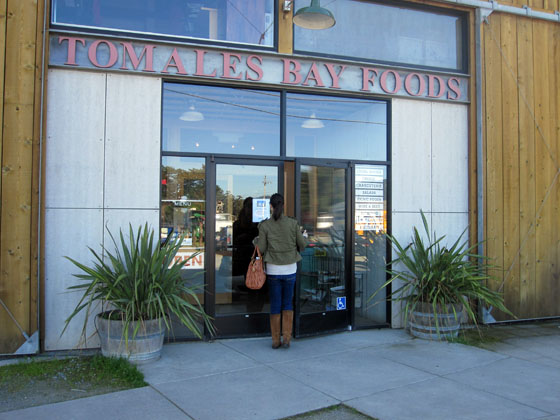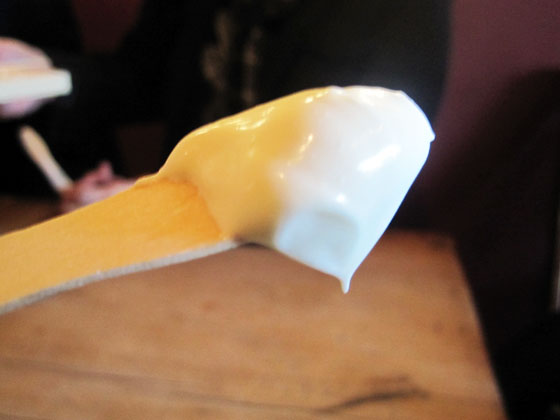The first tasting was crème fraîche:
Crème fraîche is made from a simple heavy cream with a little bifidus culture added to make it tangy. The cheese is made exclusively from Straus milk obtained from the original herd, something that is pretty hard to come by these days. The team at Cowgirl lovingly refers to it as their "estate-bottled milk." What I didn't know about crème fraîche is that the older it gets, the better it is! Although a film may form on the top of the cheese, it can be removed and thrown out, and the crème fraîche underneath is improved by ageing. The budding novice cheesemaker can purchase their own heavy cream, add a little crème fraîche, and use it as a "mother" to create their own. At Cowgirl, the crème fraîche is the building block for all of their other fresh cheeses. I'd never thought of cheese as a "live food before," but it's true: the lacto bifidus in many cheeses creates an ever-changing product that only improves with some age.
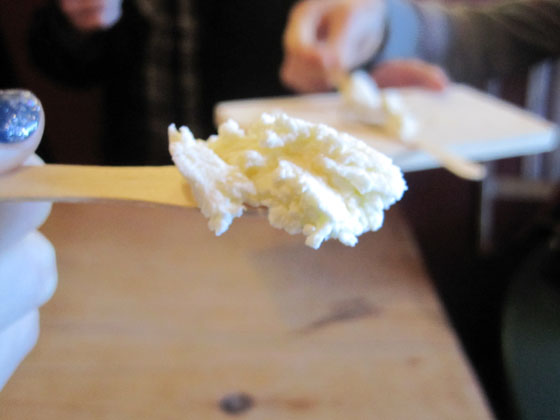
Fromage Blanc
Next on the tasting menu was fromage blanc:
The second-to-simplest cheese made at Cowgirl, fromage blanc is made by heating milk, adding the culture (lactus bifidus) to create acids and coagulate the milk, and hanging the resulting cheesecloth overnight to drain out the whey. The resulting cream cheese is a crisp, clear, clean cream cheese without any cloying xanthan gum. It tastes absolutely unlike anything I've ever had on a bagel and I know I'll never be able to eat Philadelphia again.
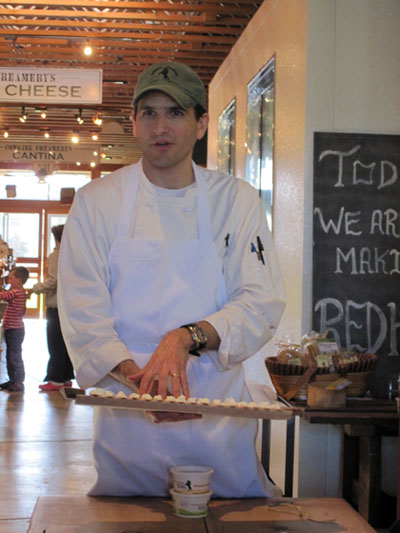
Manager Michael Zilber discusses clabbered cottage cheese
Then, it was time to try the clabbered cottage cheese:
This cheese is the first one that Sue ever made, and we hear it's the one she's still most proud of. Traditionally, cottage cheese is made from the nonfat milk that's left over from the day's butter-making. The milk is turned into whey and mixed with fresh cream from the morning's milking, which is why cottage cheese is traditionally a breakfast cheese. This cheese has great acidity and texture, and we're told it can be substituted for ricotta in almost any recipe. This cheese won a blue ribbon from the American Cheese Society in 2005, making it ostensibly the best cottage cheese in the USA. "What it comes down to is highlighting the high-quality milk," says our guide, cheesemonger/manager Michael Zilber, modestly.
AGED CHEESES
After a year of making fresh cheeses, Sue decides to try her hand at making some aged cheeses. At the time, a Dutch dairy scientist was interning at Cowgirl. With his input, the creamery as it is today was designed, and Cowgirl made its first soft aged cheese: basically a creamy Gouda. Many tests-and-repeats later, Cowgirl is probably known best for its famous Mount Tam cheese.
Mount Tam:
We learned that cheese ripens from the outside in, which can be noticed in the three different textures of the triangle of Mount Tam we were given to examine, sniff, and taste. The rind, which is made from candida mold that has broken down the milk and made a seal, is white and fluffy. Just inside the rind there's a ribbon of ripe cheese, and inside of that, the center of the cheese is a firm, bright white. "To really dork out on soft cheeses," says our guide, "first taste the center, and taste the ripe part of the cheese second. For the third nibble, taste the two parts together." All three bites had their own distinct flavors.
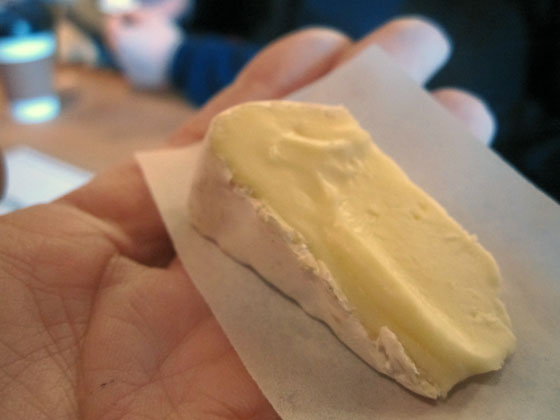
Three stages of ripeness in one slice of Mount Tam
Also, says Zilber, "anyone who says they are lactose-intolerant should be able to eat aged, soft cheeses." Why? "The cultures added to the cheese eat all of the lactose after a few days of aging and turn it into lactic acid." Hence, the slightly acidic, citrusy tang we taste in a newer cheese. The mold feeds on that acid, sweetening the cheese. "So a cheese's rind not only seals but sweetens the cheese."
Red Hawk:
The next cheese we tasted was the Red Hawk, which is made similarly to the Mount Tam. After two weeks of aging, the fluffy candida mold is scrubbed off of the cheese and it's washed with salt water. (Some cheesemakers will wash the rinds with beer or wine at this stage of cheesemaking.) The saline prevents more white fluffy mold from growing and then nature takes over. B. Linens mold from the air grows on the cheeses giving them their nuttiness and a slight funk. B. Linens mold is a naturally-occurring mold in the air--it's what makes stinky cheeses like Limberger stinky. Red Hawk represents the terroir of West Marin--it cannot be made in Petaluma, because the air doesn't have the mold. It is a true American original: the only known washed-rind, triple-cream soft cheese in the world. Pair it with a true Sauternes or a hoppy IPA.
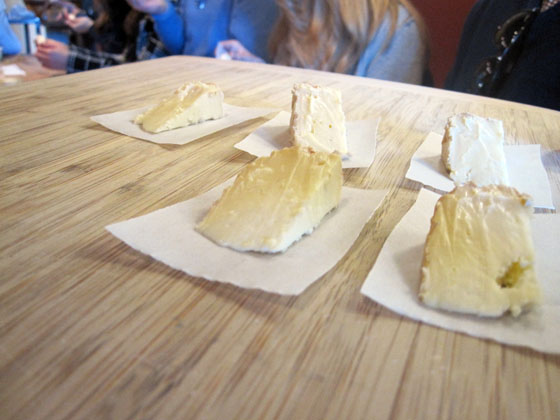
Individual slices of the washed rind, triple-cream Red Hawk
Devil's Gulch:
This seasonal cheese is soft and aged, with a sweet and spicy pepper rind. Cowgirl's seasonal cheese is the same cheese year-round, with different herbs to finish the rind. The cheese itself is a washed rind, similar to the Red Hawk but the milk is from a Jersey cow farm. There is no cream added to the cheese because the fat content in Jersey cow milk is higher than that of Holstein cows, which is where the "estate-bottled" Straus milk comes from.
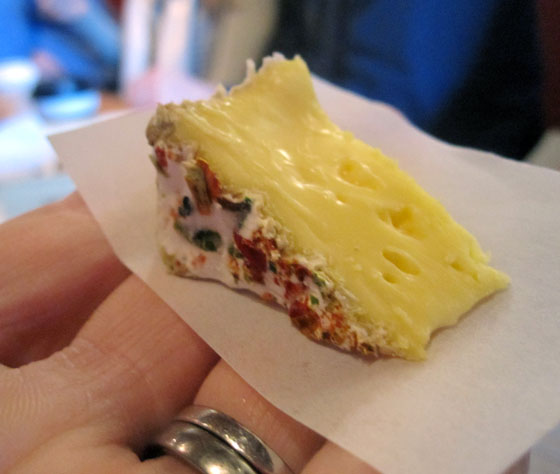
Homegrown dried pepper rind on Devil's Gulch cheese
Wagon Wheel:
After years of making fresh cheeses and soft aged cheeses, Cowgirl's cheesemakers wanted an "everyday cheese that they could cook with," says Zilber. Wagon Wheel is their first hard-aged cheese. The process is the same as with an asiago, says Zilber. He's right that Wagon Wheel is a great melting cheese: we bought out Tomales Bay Foods' stock of Barbaclette and spent the rest of the afternoon melting it over the barbecues at the Hog Island Oyster Company for lunch.
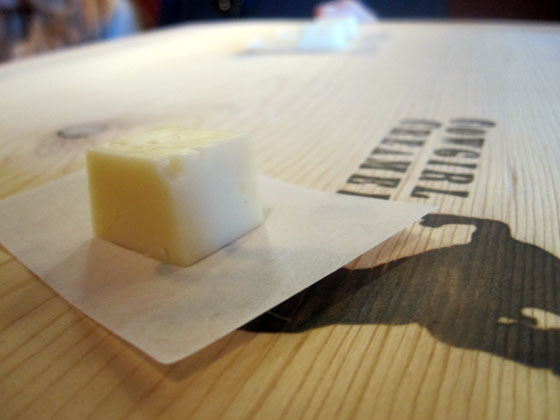
Cowgirl's first hard cheese awaits a melting
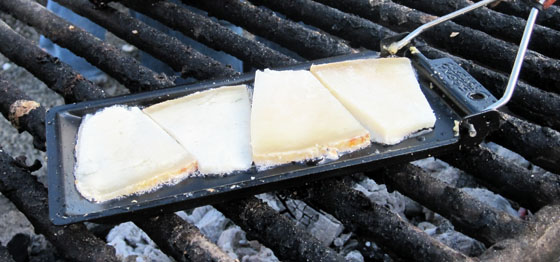
Cowgirl's Wagon Wheel melts on the grill
